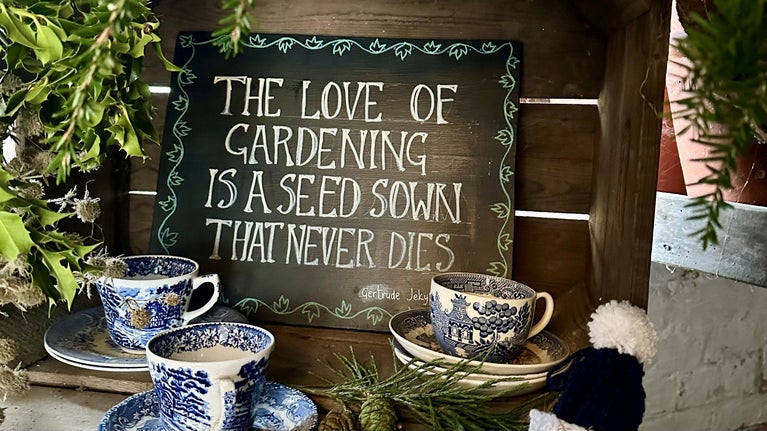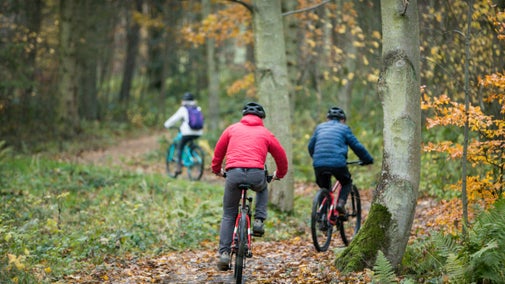
Donate
Everyone needs nature, now more than ever. Donate today and you could help people and nature to thrive at the places we care for.

Spanning four acres, the walled kitchen garden at Clumber Park is one of the grandest surviving 18th century walled gardens in England.
Originally home to the Dukes of Newcastle, Clumber Park is steeped in history with clues to its grand past dotted throughout, including this spectacular enclosed garden. Dating from 1772, it supplied the sorts of exotic and unusual foods that the Dukes could impress their guests with. From asparagus to pineapples and strawberries at Christmas, this was an elite garden for an elite family. In its prime, the gardens would have provided employment for 30 people and had 6-acres under cultivation including a huge, heated Melon Yard and an orchard, which was re-established just outside the garden walls in 2021.
The garden itself is divided internally with a bisecting peach wall to provide extra growing space for top fruit, and two garden rooms to secure the more valuable soft fruit crops. The 15-foot walls are home to over 200 wall trained fruit including cordons, espaliers, and fans.
The Clumber gardens team practice “no dig” gardening in two large plots near the top of the garden. Each year, they provide fresh crops using organic principles for use in the park's food and beverage outlets, and for sale on the well-stocked produce cart. All generating much needed funds from visitor donations.
The gardens now have a mixture of productive and ornamental plantings and is home to two national collections of Rheum (Rhubarb) and Malus (Apple).
The garden is landscaped to encourage cold air and frost to roll from the flanks into the centre of the garden and then down a central slope through metal gates at the lowest point of the garden. This leads onto the impressive Cedar Avenue, which is underplanted with 140,000 spring flowering bulbs, creating a spectacular blanket of colour in the spring months.

At 451 feet, Clumber Park boasts the longest Glasshouse in National Trust care. It was installed by the 7th Duke of Newcastle and completed in 1910. By the 1970s it was derelict but the Trust has spent decades restoring it, most recently in 2023.
Today, it boasts spectacular seasonal displays in its huge conservatory, an exotically planted Palm House and bays of grapes, figs, and peaches.
The Apple Store is a feast for the eyes with ever-changing displays of dried flowers, and the Gardener's Mess Room documents the life of past Gardeners.
Herb border
Combining herbs grown for the cafe, alongside dianthus. The latter a homage to the 7th Duchess and the gardeners who grew her favourite carnations.
Rose garden
With over 40 pre-1920s varieties, it is also planted with bulbs, annuals and herbaceous perennials to create a display that lasts from spring to autumn.
Soft fruit garden
Home to over 50 varieties, including strawberries and raspberries.
Double herbaceous borders
At 400ft, they are the longest of their type in the National Trust's ownership.

In January, the team start the gradual process of remaking the no-dig beds. This involves reshaping the beds with wooden formers, topping up the compost levels and refreshing the paths with woodchip. They also start covering all the other beds and borders with a layer of compost. In a no-dig system this is all that is required to replenish nutrients – no other fertiliser is needed. This year, the team are ahead and have remade many of the beds already,
Pruning of the roses in the rose garden can begin this month, as can the winter pruning of the apple and pear trees.
On the days when the team can’t get out into the garden because of the weather, they clean the Glasshouse, strip and clean the vines and wash plant pots.
What’s for sale on the produce cart?
Kale, pak choi and rhubarb crowns
January is a pivotal time for gardeners, with festivities over and day length increasing, it’s understandable that it feels like the start of a new gardening year, even if the meteorological winter runs until February.
While taking a well-earned break from weeding and mowing, it’s a great time to take stock of what worked well during the past year and while we’re at it, why not look further?
We are somehow more than a quarter of the way through this century already and when I think back an entire generation to concerns about millennium bugs and dot.com bubbles, it’s hard not to think about our climate then and now. For Nottinghamshire, we have seen a significant upwards trend of 0.6C increase during this period. By 2050 our climate in the county is set to be similar to that of Southern France and while swapping Sherwood for St Tropez may sound appealing for some, it doesn’t come without its costs to our gardens.
There are two impactful things you can do in 2026. The first is to conserve irrigation water. Using rain butts connected to down pipes and recycling grey water from dish washing and bathing can help here. Irrigate during the cooler parts of the day and consider a moisture-trapping mulch to borders and containers. Finally, look at drought tolerant plants when selecting for new plantings. These small steps can help us prepare for the coming decade and the new challenges that come with it.
The second is to reduce peat use. Extracting carbon-sequestering peat from bogs is highly damaging. The ban on amateur peat use is now in effect but the commercial ban won’t be in place until 2030. Ask for peat free plants at your nursery, this consumer demand will only help further this cause.
Here’s to another great year of gardening across Nottinghamshire. May your crops be fat, and your pests be few.
All the best,
Dene Wood

Walled Kitchen Garden Tour, first Tuesday of every month from March - October, 11.30 – 12.30
As one of only a handful of its kind in existence, discover how the walled kitchen garden is maintained using traditional gardening techniques.
Meet at the entrance to the garden.
Rhubarb Week, each April
The walled kitchen garden is home to the National Rhubarb Collection with over 130 varieties grown here. Enjoy tours and tastings throughout the week.
Blossom Festival, each May
Celebrate blossom season in the walled kitchen garden with a vibrant festival.
Apple Celebrations, each October
With over 70 varieties of apples, including a National Collection, there’s a lot to celebrate here at Clumber Park when it comes to apples.
The Garden's team have answered the most common questions asked by visitors to the walled kitchen garden.
How many staff and volunteers work in the garden?
4 full time staff, 3 part time staff, 2 garden apprentices and 40-45 frequent volunteers
How many would have worked here in its heyday?
Around 30 gardeners
If you are the second largest collection of rhubarb in the world, who has first?
We understand a private collection in the Netherlands currently has the largest collection
How big are the walled gardens?
4 acres within the walls, but including the slip gardens, frame yards and historic orchards it's 6 acres.
How long are the Glasshouses?
451 feet/137.5 metres. It takes around one and a half minutes to walk at a steady pace from one end to the other. It is the largest range of glass owned by the National Trust.
What happens to the produce?
We sell our produce to visitors on the cart near the entrance gate. A weekly delivery is also made to the main café in the Turning Yard.
What happens to all the rhubarb?
From March to July we have rhubarb sticks for sale on our produce cart and it is used for seasonal recipes in the cafe. We don't pick the stalks after this time as the rhubarb needs to gather and store energy for growth. Throughout autumn and winter the rhubarb naturally dies back and will re-emerge in February at the beginning of the growing season.
What happens to all the apples?
We have around 250 apple trees at Clumber. We pick the apples in September and October. Some are sold on the produce cart, some go to the café, some are used at our annual apple celebration event. Some heritage varieties are good for storing and can be brought out to sell during the winter.
In winter, birds rely on the late apples that drop off our ‘Bess Pool’ apple trees. At the coldest time of year when the ground is frozen and food is scarce, dozens of blackbirds as well as winter migrants, such as fieldfares and redwings, will feed on them.
Any apples that are not eaten by the birds will rot down into the soil and release nutrients back to the apple trees to produce next year’s crop.
Where are the toilets?
On the east side or the left side of the garden if looking from the main gates up to the Glasshouse.
How do I get to the nearest café (Central Bark)
Follow the path that goes east at the main gates, keeping the walled garden on your right, until you reach the woodland. Turn right (north) and walk through the trees until you get to the tarmac path and then turn right. Central Bark will be on the right.
What time is the garden open?
The garden is open every day from 10.00 - 16.00.

Everyone needs nature, now more than ever. Donate today and you could help people and nature to thrive at the places we care for.
Make the most of your garden or growing space this spring with tips and advice from our gardeners. Find out about pruning shrubs, preparing flower borders, planting early vegetables and choosing the best blossom trees.

One way to support the National Trust, while also spending time in amazing places and making new friends, is to volunteer. Find out more about joining the dedicated team of volunteers working to make Clumber Park a beautiful place to visit.

Clumber Park is a three pawprint rated place. Exploring the 3,800 acres of beautiful parkland with your dog by your side is one of the best ways to see Clumber Park.

From wild adventures in the woods to family bike rides around the estate, there are plenty of ways to make memories at Clumber Park this winter.

The 19th century Chapel of St Mary is a must-see on a visit to Clumber Park.

Discover the grand past of Clumber Park; as a hunting ground for royalty, under the care of 13 Dukes and its connections to the Second World War.

From lakeside runs to woodland rides, Clumber Park has 20 miles of trails for cyclists, runners and walkers to explore. Bridlepaths through the estate provide an opportunity to explore on horseback.

Whether you're looking for food, drink or the perfect gift, Clumber Park has something for everyone.
